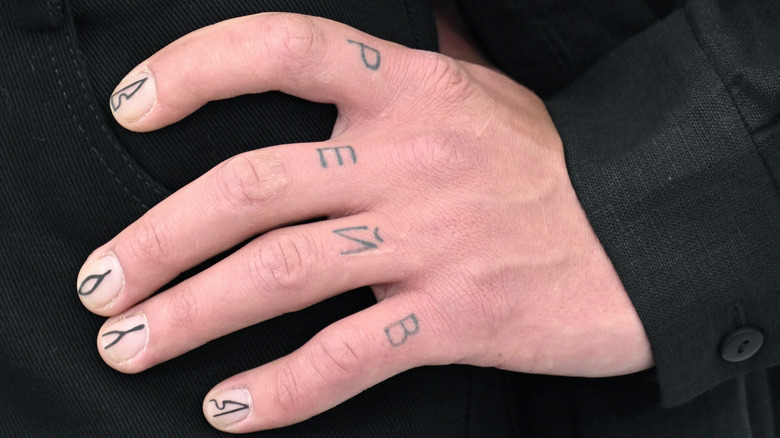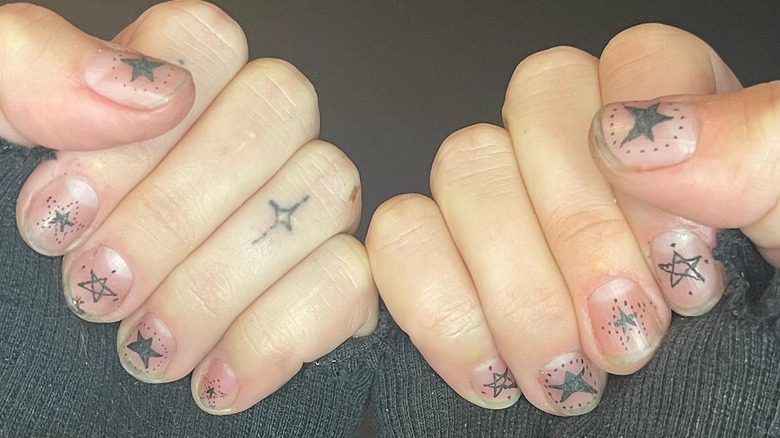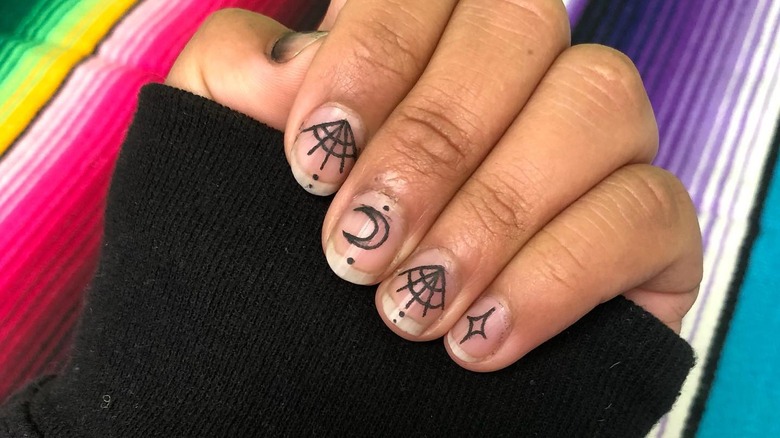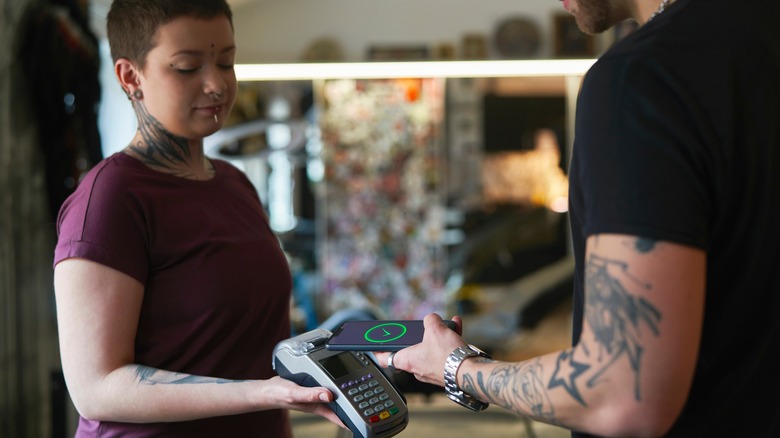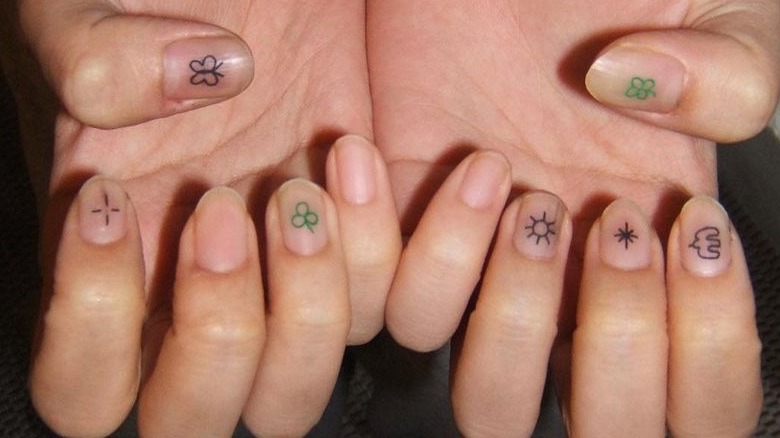What Are Nail Tattoos And Are They Safe?
Tattoos have seen a major surge in mainstream social acceptance over the past few decades. Once mostly reserved for biceps, ankles, and lower backs, this permanent form of body art has now become commonplace even on the forearms, hands, legs, and faces of over a quarter of adults in the U.S., as reported by Ipsos. Even professionals now sport visible tattoos in many areas in the United States, which was once unheard of. As proudly displayed tattoos become more and more of a norm across the country, it only makes sense that new variations would emerge.
The latest tattoo trend to grace the beauty communities of social media platforms like TikTok, Instagram, and Pinterest is nail tattooing. This delicate art, shared by users like tattoo artist @Avalonvaloretattoo, involves using a tattoo gun to etch a small image or symbol into the surface of a fingernail. But what all does this nail trend entail, and is it safe?
The nail tattoo process
To take the first step on your nail tattoo journey, you'll need to locate a reputable artist in your area familiar with the process who has a style that works with your vision. While any artist may technically possess the equipment and basic training necessary to tattoo your fingernails, you should find someone who has knowledge of or specializes in nail tattoos for the best experience. This reduces the risk of complications and will help ensure that your nail design meets your standards.
Once you have found an experienced artist who you want to work with, you'll want to arrange a consultation to discuss your design goals. A good artist will be honest about the limitations of using fingernails as a canvas and will let you know if you need to adjust your expectations. After you have agreed on a feasible design, you just need to schedule and attend the actual tattooing session.
Does getting a nail tattoo hurt?
On the surface, the nail tattoo process works much like applying any other tattoo using a tattoo gun. However, the difference lies in the fact that the artist injects ink into the fingernail instead of the dermis. This will likely come as great news for individuals who fear the pain associated with the traditional ink experience. Since tattooing the nail does not involve piercing the skin, you don't need to expect any pain.
"It doesn't hurt. It feels more like pressure on your nail, or if you've gone to the nail salon, it feels like when they use the [electric file] to sand your nails down," New York City-based tattoo artist Gabby Pignanelli told Allure. "I've heard that if you have thinner nails, it can be a little pinch-y." If you are particularly sensitive to touch, pressure, or vibration, you may find this slightly uncomfortable, but it should not hurt. This makes nail tattoos an excellent choice for individuals who want to get inked but have a low pain tolerance.
How long will a nail tattoo last?
Getting a traditional tattoo can be a difficult decision due to its permanent nature. Once inked onto your skin, it becomes a lifelong commitment unless you have access to laser removal in the future. However, a tattoo on your fingernail is a different story. Since the ink is applied to the actual nail, not the skin, it allows the nail tattoo to grow out with your fingernail. This makes nail tattoos a low-commitment ink trend, much like stick-and-poke tattoos.
Tattooing on the nail is technically permanent, meaning the image won't fade away or wipe off the fingernail over time. However, it will grow out and eventually be cut or — let's be real — chewed off to reveal a brand-new blank canvas beneath. This regrowth process can take up to six months, according to Healthline, depending on how fast your nails tend to grow. While this may be disappointing for those who loved their designs, it also presents an opportunity to change your look whenever you want. With nail tattoos, you can experiment with different tattoo art styles every few months without being stuck with a particular design forever.
How much does a nail tattoo cost?
Pricing can vary widely when it comes to tattoos. The size and complexity of the design, whether it was pre-designed or custom-made, the geographical location, the artist's experience level, and the location of the tattoo on the body can all play a part in determining how much you'll pay. When it comes to a nail tattoo, you can expect to spend about the same amount as you would for a similar design on your skin.
A very small and simple nail tattoo might only cost you $40 or $50, while a larger, more intricate design could reach into the $300-400 range. Be sure to openly discuss pricing with your tattoo artist during the planning phase of your tattoo, so you don't end up surprised at the end of your appointment. If you have a particular budget in mind, share it with your artist so that they can suggest simplifications to help you stay within it. And don't forget to factor in a tip on top of the base price.
Is it safe to get a nail tattoo?
In general, getting a tattoo on your fingernail is about as safe as getting one on your skin. All the same risks apply, including infection and allergic reactions to the tattoo ink, according to the Mayo Clinic. However, there are a few special considerations when it comes to tattooing nails. The first is depth. If the tattoo is applied too deep, it could penetrate the skin under the nail, increasing the chance of infection and leaving permanent ink markings and/or scarring. Since the tissue is contained under the fingernail, swelling or bleeding could lead to acute compartment syndrome, which OrthoInfo categorizes as a medical emergency.
Another risk unique to fingernail tattoos is nail splitting. If too much pressure is applied with the needle, nails can crack or split in half. This leaves the nail bed exposed, which can be very painful and lead to infection. At the very least, the nail will be lost and you'll have to wait for it to regrow. A skilled and experienced tattoo artist should be well aware of these risks and understand how to tattoo nails in a way that minimizes the risk involved. Be sure to ask questions and view the artist's work before booking your appointment.
